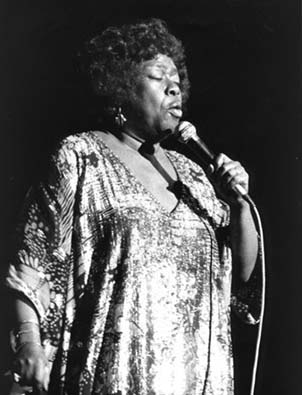| B i o g r a p h y |
 Sarah Lois Vaughan
(nicknamed "Sassy" and "The Divine One") (March 27, 1924, – April 3,
1990,) was an American jazz singer, described by Scott Yanow as having
"one of the most wondrous voices of the 20th century". Sarah Vaughan
was a three time Grammy Award winner. The National Endowment for the
Arts bestowed upon her its highest honor in jazz, the NEA Jazz Masters
Award in 1989.
Sarah Lois Vaughan
(nicknamed "Sassy" and "The Divine One") (March 27, 1924, – April 3,
1990,) was an American jazz singer, described by Scott Yanow as having
"one of the most wondrous voices of the 20th century". Sarah Vaughan
was a three time Grammy Award winner. The National Endowment for the
Arts bestowed upon her its highest honor in jazz, the NEA Jazz Masters
Award in 1989.
Sarah Vaughan's contribution to the female jazz vocal genre, during the twentieth century, puts her alongside the likes of Dinah Washington, Billie Holliday and Ella Fitzgerald. As a child Sarah Vaughan sang in church and had extensive piano lessons from 1931-39, which helped her become a capable keyboardist. After she won an amateur contest at the Apollo Theatre, she was hired for the Earl Hines big band as a singer and second vocalist. Unfortunately, the musicians' recording strike kept her off record during this period (1943-44). When lifelong friend Billy Eckstine broke away to form his own orchestra, Vaughan joined him, making her recording debut. She enjoyed her time with Eckstine's orchestra, where she became influenced by a couple of his sidemen, Charlie Parker and Dizzy Gillespie, both of whom had also been with Hines during her stint. Vaughan was one of the first singers to fully incorporate bop phrasing in her singing, and to have the vocal chops to pull it off on the level of a Parker and Gillespie. Apart from a few months with John Kirby from 1945-46, Sarah Vaughan spent the remainder of her career as a solo star. Although Sarah held an unusual stage appearance in 1945 (her first husband George Treadwell would greatly assist her with her appearance), there was no denying her excellent voice.
She made several early sessions for Continental: a 31st December,
1944 date highlighted by her vocal version of 'A Night In Tunisia,'
which was called 'Interlude,' and a 25th May, 1945 session for that
label that had Gillespie and Parker as sidemen. However, it was her
1946-48 selections for Musicraft (which included 'If You Could See Me
Now,' 'Tenderly' and 'It's Magic') that found her rapidly gaining
maturity and adding bop-oriented phrasing to popular songs. Signed to
Columbia where she recorded during 1949-53, 'Sassy' continued to build
on her popularity. Although some of those sessions were quite
commercial, eight classic selections cut with Jimmy Jones' band during
18-19th May, 1950 (an octet including Miles Davis) showed that she
could sing jazz with the best. During the 1950's, Sarah recorded
middle-of-the-road pop material with orchestras for Mercury, and jazz
dates (including a memorable collaboration with Clifford Brown) for the
label's subsidiary, EmArcy. Later record label associations included
Roulette (1960-64), back with Mercury (1963-67), and after a surprising
four years off records, Mainstream (1971-74). Through the years,
Vaughan's voice deepened a bit, but never lost its power, flexibility
or range. She was a masterful scat singer and was able to outswing
nearly everyone (except for Ella). Vaughan was with Norman Granz's
Pablo label from 1977-82, and only during her last few years did her
recording career falter a bit, with only two forgettable efforts after
1982. On of her final recordings were the 'Brazilian Romance' sessions,
where Sarah worked alongside many greats from that country, including
Ivan Lins.A fine swansong to an excellent career.